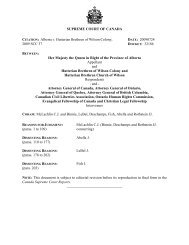Canada (Attorney General) v. Bedford, 2012 ONCA ... - York University
Canada (Attorney General) v. Bedford, 2012 ONCA ... - York University
Canada (Attorney General) v. Bedford, 2012 ONCA ... - York University
Create successful ePaper yourself
Turn your PDF publications into a flip-book with our unique Google optimized e-Paper software.
Page: 75[175] Bawdy-houses were initially dealt with as forms of vagrancy and nuisance.With the 1953-1954 revision of the Criminal Code, the bawdy-house provisionswere relocated to Part V (now Part VII), which deals with “Disorderly Houses,Gaming and Betting”; they are no longer associated with vagrancy. The SupremeCourt subsequently held in R. v. Patterson, [1968] S.C.R. 157, that proof thatpremises were a bawdy-house required evidence that the premises wereresorted to on a habitual and frequent basis.[176] The bawdy-house provisions in the Criminal Code are rooted in ancientEnglish criminal law. However, the Canadian approach differs from the Englishapproach in at least one significant respect:in England, a place is not a“common” bawdy-house when it is used by only one prostitute. By contrast, in<strong>Canada</strong>, by reason of a 1907 amendment to what is now s. 197(1) of theCriminal Code, a “common bawdy-house” is defined as a place that is kept oroccupied or resorted to “by one or more persons” (emphasis added).[177] The result is that a person who wishes to engage in prostitution in her ownhome runs afoul of s. 210: see R. v. Worthington (1972), 10 C.C.C. (2d) 311(Ont. C.A.); R. v. Cohen, [1939] S.C.R. 212. Obviously, a group of prostitutesworking together for reasons of safety, or otherwise, in a single place, would alsoviolate the bawdy-house provisions as keepers or inmates.
















